Choosing the Right Paint Gun for Interior Projects
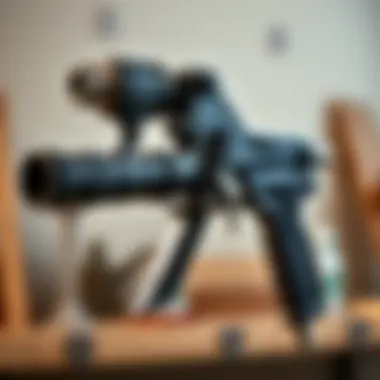
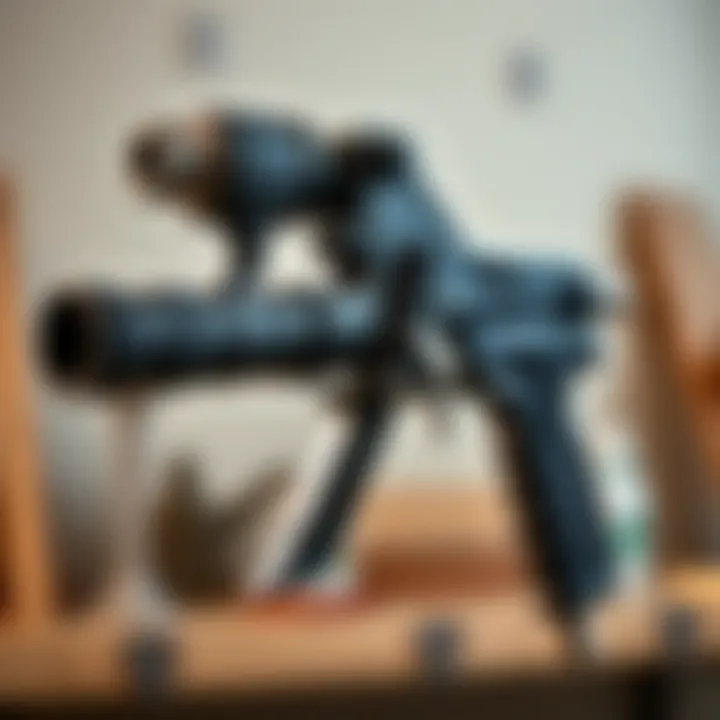
Intro
When embarking on a journey to revamp your home, the right tools can make a world of difference. Among these, a paint gun stands out as a powerful ally. Whether you're tackling a small room refresh or a grand renovation, understanding how to choose and effectively use a paint gun will elevate your results from mundane to magnificent. This guide is tailored for homeowners, interior design enthusiasts, and DIY aficionados eager to enhance their spaces with finesse.
Painting your home's interior can often feel overwhelming. With shelves stocked full of colors, finishes, and equipment, it’s easy to hit a wall (pun intended) before you even pick up a brush. A paint gun simplifies the process, offering a smooth finish, quicker application, and a significant reduction in paint waste. But with various types and models out there, how do you decide which one is right for your project?
Delving into the world of paint guns uncovers their numerous advantages, while the right preparation and maintenance ensure they remain reliable for the long haul. This article will break it all down, step by step, offering insights into design inspirations, operational best practices, and long-term upkeep—all aimed at helping you achieve stunning results without the headache.
So roll up your sleeves and let’s dive into the colorful world of paint guns!
Preamble
When it comes to sprucing up your interiors, knowing how to paint efficiently can transform an average space into something spectacular. One tool that has surged in popularity among DIY enthusiasts and professionals alike is the paint gun. This article aims to provide a detailed understanding of paint guns, exploring their nuances, advantages, and how to leverage them for the best outcomes.
Using a paint gun isn’t just about spraying paint; it’s about technique, precision, and, most importantly, preparation. A well-executed paint job can dramatically uplift the aesthetics of your home, making it feel fresh and inviting. Moreover, choosing the right paint gun can save you time and enhance your painting experience.
Why Choose a Paint Gun?
The merits of utilizing a paint gun are many. First off, the efficiency and speed offered by these devices cannot be understated. They can cover large areas much faster than traditional brushes or rollers. Not to mention, paint guns allow for a smoother finish. With a controlled and even spray, you avoid the telltale brush strokes that often plague more manual methods of painting.
However, the choice to use a paint gun also comes with its own set of considerations. For instance, if you’re new to this method, expect an initial learning curve. There’s a skill to handling a paint gun that you might not have with a brush or roller. Moreover, the equipment costs can be higher than conventional painting supplies, so assessing whether it's worth it based on your project needs is crucial.
Key Takeaways
- Understanding the importance and mechanics of using a paint gun sets your project up for success.
- The ability to create a polished finish can enhance your home’s appeal significantly.
- Recognizing both the advantages and the drawbacks prepares you better for the endeavor ahead.
By the end of this guide, you’ll be equipped with all the necessary knowledge to choose and use a paint gun effectively. Whether you’re painting an accent wall or refreshing your entire living space, the insights you gain will help you realize your vision with flair and finesse.
Understanding Paint Guns
In the world of painting, especially when it comes to interior projects, using a paint gun can be a game changer. Understanding paint guns is crucial for anyone looking to enhance their home effectively and efficiently. It serves as a foundation for making informed decisions regarding which type of gun to use, the methods for application, and the overall benefits you can reap.
What is a Paint Gun?
A paint gun is a device that atomizes paint and propels it onto a surface. They come in various shapes and sizes, designed to suit different types of tasks. The right paint gun can help homeowners achieve a level of finish that is often difficult to get with traditional brush or roller methods. It enables smooth application, controlled flow, and can save considerable time, particularly on larger projects.
Types of Paint Guns
When diving into the subject of paint guns, there are three main varieties you’ll typically encounter: Airless, HVLP (High Volume Low Pressure), and Compressed Air Paint Guns. Each type has its unique characteristics and advantages, making it essential to choose wisely based on the project requirements.
Airless Paint Guns
Airless paint guns operate by pushing paint through a hose at high pressure. The biggest draw here is their efficiency. They can cover large areas in a short time. The spray pattern is often broader than traditional methods, minimizing the chances of missing spots. Ideal for exterior walls and other sizeable surfaces, these guns deliver a smooth finish without requiring the constant back-and-forth movement seen with a brush.
However, they can take a bit of practice to master. One drawback is the potential mess—overspray can be a headache, and they need careful handling. Still, for many, the trade-off in time and finish quality makes them a popular option for interior projects.
HVLP (High Volume Low Pressure) Paint Guns
HVLP guns are known for their ability to produce fine finishes with minimal overspray. They work by using a high volume of air at low pressure, allowing for more control and precision while applying paint. This can be particularly beneficial for intricate jobs such as furniture refinishing or detailed cabinetry.
A key characteristic of HVLP guns is the reduced material waste. You’re not just saving on cleanup but also on purchasing additional paint. Nonetheless, be aware that they might require thinning of certain paints for optimal performance, which could add to preparation time. Overall, their efficiency and precision make them a strong contender for many interior home projects.
Compressed Air Paint Guns
These are the traditional guns that many professionals often favor. Using compressed air, they mix air with paint to create a spray. Known for versatility, compressed air guns can handle a variety of paint types, but their real strength lies in their ability to provide a smooth finish.
The downside, however, is that they often involve a complex setup, needing a compressor and multiple adjustments to find the correct spray pressure. They are more suitable for experienced users who can navigate the learning curve involved.

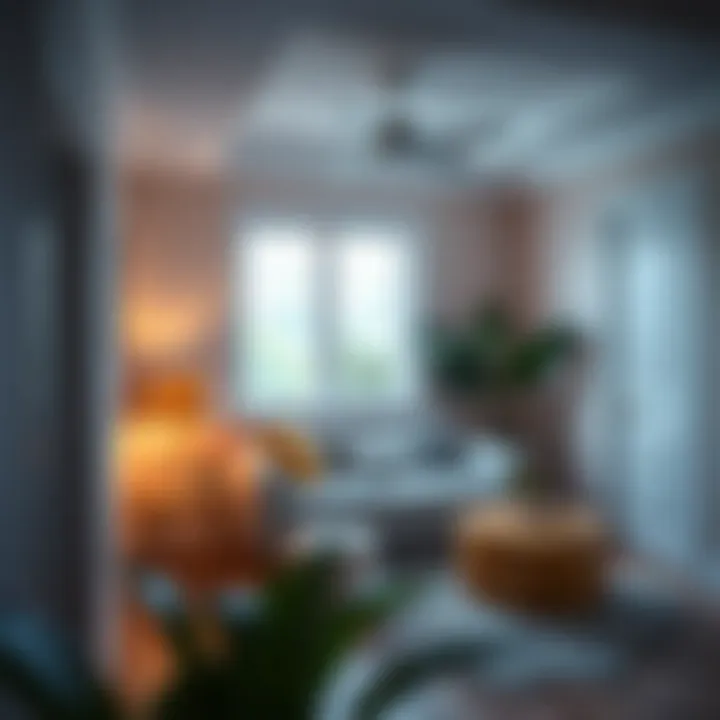
In summary, understanding these types of paint guns will guide homeowners in making the best choice for their interior home projects. Each gun brings its own set of advantages and considerations, making the selection process all the more crucial for achieving optimal results.
Benefits of Using a Paint Gun
Using a paint gun can greatly enhance your interior painting project. While traditional brushes and rollers have their uses, paint guns bring a host of advantages that can make your task simpler, faster, and more efficient. With the right tool in your hands, you can change up a room in no time and achieve results that leave you smiling with satisfaction. Let’s unpack the key benefits.
Efficiency and Time-Saving
One of the most significant perks of using a paint gun is the efficiency it brings to the table. When you’re gearing up for a big painting job, time is often of the essence, especially if there are multiple rooms to tackle or guests on the horizon. Paint guns can spray an even coat quickly, dramatically reducing the amount of time spent on each task.
For example, if you’re painting the ceiling of your living room, using a roller can take time as you have to reload it with paint repeatedly and be meticulous about your strokes. However, with an airless paint gun, you can cover that same surface in a fraction of the time with minimal effort. This means less time standing on ladders and more time enjoying your newly refreshed space.
- Fewer Coats Required: Compared to traditional methods, a paint gun often means fewer coats are needed to achieve full coverage.
- Reduced Drying Time: Many paint guns use a fine mist technology, leading to quicker evaporation of the paint.
Smooth and Even Finish
A smooth and even finish is something every homeowner strives for, but achieving that can sometimes feel like chasing a unicorn with a brush and roller in hand. Streaks and roller marks can often sneak into your finished work. Using a paint gun changes the game by creating a layer of paint as smooth as butter.
One of the reasons a paint gun provides such a fine finish is that it atomizes the paint into smaller particles. This results in better coverage without clumping or uneven textures. Moreover, you’re able to maintain consistent paint flow, which means you can apply the paint without interruption. A well-executed application can yield walls that look professionally done—a stark contrast to the more labor-intensive methods.
"A good paint job isn’t just about color; it’s about the smoothness of the finish that tells the real story."
Versatility in Application
Paint guns are not just limited to walls. Their versatility makes them suitable for a myriad of applications, from furniture to intricate moldings. If you’ve got a project in mind, chances are a paint gun can handle it and handle it well.
- Furniture: Refresh old furniture by applying new paint smoothly with a gun instead of a brush. It offers freedom to maneuver in those tricky corners and curves.
- Moldings and Trim: Instead of tedious brushing, a paint gun can make quick work of detailed work, saving you from backache while providing a professional finish.
- Outdoor Projects: The potential doesn’t stop indoors. Many homeowners find themselves using paint guns on fences, decks, and patios as well.
Whether a simple touch-up or a large paint overhaul, paint guns provide flexibility that traditional methods simply can't match. It’s all about making the job easier and the end results sharper.
In summary, adopting a paint gun for your interior home projects brings with it efficiency, a smooth finish, and versatility that significantly enhances your painting experience.
Potential Drawbacks of Using a Paint Gun
Using a paint gun can transform your interior painting process, but nothing's perfect. It’s critical to weigh the benefits against potential drawbacks. This section helps you understand some challenges you might encounter. By knowing what to expect, you can plan better and make informed decisions when tackling your projects.
Learning Curve
One of the first hurdles you’ll likely face is the learning curve associated with paint guns. Using a paint gun isn't like picking up a brush and slapping paint on the wall. This isn’t to say it’s rocket science, but there's a bit of a finesse involved. Whether it’s the right angle, distance, or pressure, mastering these elements can take some practice.
For instance, a newbie might start too close to the wall, resulting in streaks or uneven coverage, making for a less-than-stellar finish. Conversely, if you're too far back, the paint may not adhere properly or could lead to over-spray. It's wise to spend some time practicing on scrap materials or a less visible surface before diving into your main project. Familiarizing yourself with the equipment will reduce frustration in the long run.
Overspray Issues
Next on the list of potential drawbacks is overspray. If you’ve never used a paint gun before, expect a little bit of a mess. Overspray refers to the paint that lands on surfaces you didn’t intend to paint. It's a genuine concern especially in indoor spaces where you might not want a splash of color on your floor or furniture.
You might consider using a drop cloth or masking tape to protect areas you want to keep paint-free. Even with precautions, some overspray could still occur. Take into account that the cleanup afterward might require additional effort. So, make sure you allocate enough time for protection and cleanup in your project timeline.
Equipment Costs
Lastly, let's talk about the costs involved. Paint guns, while perhaps not extravagant, can still put a dent in your wallet. High-quality models, especially those that come from reputable brands like Graco or Wagner, may run anywhere from a few hundred to over a thousand dollars.
Moreover, apart from the initial purchase, keep in mind additional costs for accessories like spray tips and filters. Then there’s maintenance. Regular cleaning and upkeep is necessary to prolong the life of your equipment and ensure optimal performance. Some might find that a good quality roller with a tray suits their needs just fine and is easier on the budget.
In summary, while using a paint gun can enhance the efficiency and finish of your projects, it's important to consider these potential drawbacks. Having a clear understanding can empower you to make the best decisions for your painting endeavors.
Selecting the Right Paint Gun for Your Project
Choosing a paint gun is no small feat, especially with the range of options available today. It’s like picking the right tool for a delicate job; you wouldn’t use a hammer for a screw, would ya? Selecting the right paint gun can make or break your project. The right choice not only saves time but also ensures a professional finish. Misunderstanding your needs can lead to overspending on features you may never use or poor results that make you want to pull your hair out.
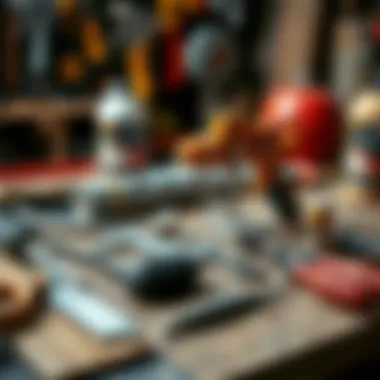
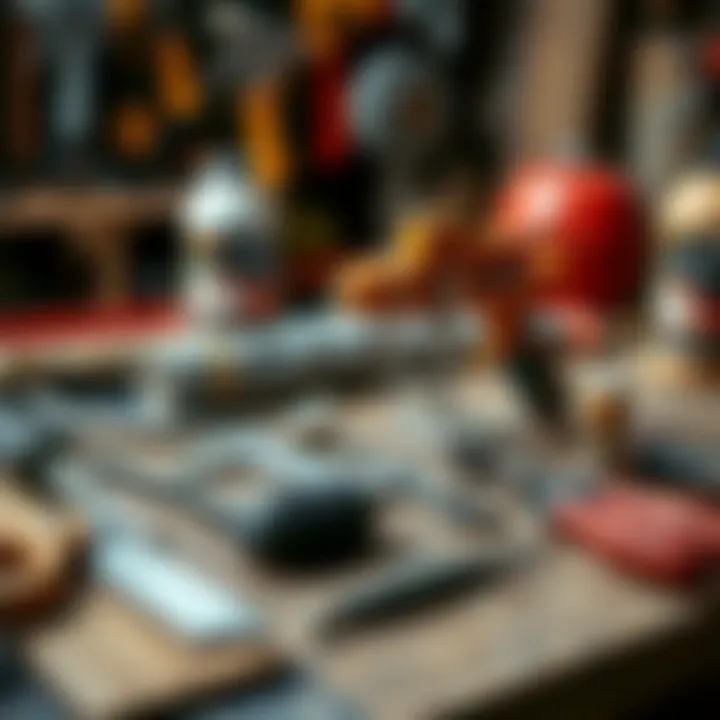
Assessing Your Needs
Before diving into the sea of different paint guns, it’s critical to take a step back and evaluate what exactly you need from your tool. Are you tackling vast walls or just touching up a few nooks and crannies? Knowing the scope of your project helps narrow down your options.
You might be looking for something lightweight and maneuverable for intricate areas or a heavy-duty model for large spaces. Think about the type of paint you’ll be using, as well; certain guns are better suited for thicker materials than others. Jot down your requirements and keep them close at hand when researching.
Key Features to Consider
When selecting a paint gun, a few features stand out as essential, like adjustable pressure controls, tip sizes, and brand reliability. Ignoring these can mean the difference between a smooth application and a messy job.
Adjustable Pressure Controls
One of the standout features to look for is adjustable pressure controls. This aspect allows you to fine-tune the flow depending on your project requirements. Imagine trying to paint a delicate trim with a blast of high pressure—it'd be a disaster!
Adjustable pressure is popular for a reason; it grants you versatility. A key characteristic here is how some models provide knobs to easily dial in your desired setting. It’s like having the right seasoning in your cooking—too much or too little just won’t do! A major advantage of having this capability is that it allows for smoother transitions between different surfaces, reducing the chances of runs and sags.
Tip Sizes
Next up, we have tip sizes. This feature is vital in dictating how much paint is dispensed and how fine the spray pattern is. A smaller tip size provides greater detail, while larger ones are better for broad strokes. Knowing which tip to use can significantly enhance the quality of your finish.
The unique advantage of adjustable tip sizes is the flexibility it gives you based on the task at hand. For instance, when painting ceilings, a larger tip size can cover more area quicker, which is particularly helpful for large spaces. However, smaller tips are often necessary for detailed work; skipping this could leave your done project looking amateurish at best.
Brand Reliability
Finally, brand reliability can’t be overlooked. When investing in a paint gun, you want something that stands the test of time. Well-known brands usually come with a reputation built on years of user experiences. A reliable brand often means better customer support and quality guarantees, ensuring you’re not left in a lurch if something goes wrong.
Look for brands that have garnered positive feedback from other users. One unique feature of reliable brands is the often-robust community support that accompanies them. If you hit a snag or have questions, chances are someone out there has faced the same issues and can guide you.
Buying a quality paint gun is an investment in your home improvement, and choosing the right one can lead to long-lasting satisfaction with your projects.
Preparation for Using a Paint Gun
Getting ready to use a paint gun is crucial. It's like the calm before the storm, ensuring everything’s in place before you dive into your painting project. Proper preparation can save time, enhance your results, and make the actual painting process smoother. Nobody wants to deal with unexpected messes or hiccups mid-project. Here, we’ll break down the key elements needed to set yourself up for success with a paint gun.
Room Preparation
First things first: let’s talk about your room. This can make or break your painting experience. Clearing out the area is essential. Remove or cover furniture to shield it from accidental paint splatters. You might want to use plastic sheets or old cloths to protect the surfaces you can’t move.
Next, consider the flooring. Drop cloths are your best friend; they provide an extra layer of security against drips and spills. Lay them out carefully and secure any edges with tape if necessary to prevent slipping.
Ventilation plays a vital role too. Ensure that your space is well-ventilated by opening windows or using exhaust fans. Paint fumes can be overpowering, and breathing them in isn’t good for anyone. Plus, good airflow helps with the drying process.
Here are some steps to prepare your room:
- Clear the area by removing furniture or covering with protective sheeting.
- Secure drop cloths on the floor, taking care to cover corners properly.
- Open windows and doors for ventilation or use fans to circulate air.
Once everything is covered and aired out, you’ll have a safer, more organized environment that’s primed for painting.
Surface Preparation
Now that your room is set, let’s focus on the surfaces you plan to paint. This step is often overlooked but can greatly impact the paint's adherence and the overall finish. Start by cleaning the surfaces thoroughly. Dust, grease, or old paint can interfere with how well your new coat sticks. Use a gentle cleaner for surfaces that require it, scrubbing them down and ensuring they are free of any residues.
For surfaces with peeling paint, it’s crucial to scrape off the loose bits. This ensures a smooth surface. You can always sand areas if they feel too rough; this helps in achieving that coveted quality finish. If you’re working with wood, don’t forget to fill any holes or dents with a suitable filler. It doesn’t have to be fancy, just effective.
Below are some steps for effective surface preparation:
- Clean the surface thoroughly to eliminate dust and grease.
- Scrape off any peeling paint to ensure a smooth base.
- Sand rough areas or uneven surfaces for better paint adherence.
- Fill holes and cracks in wood or drywall with suitable filler; smooth them out before painting.
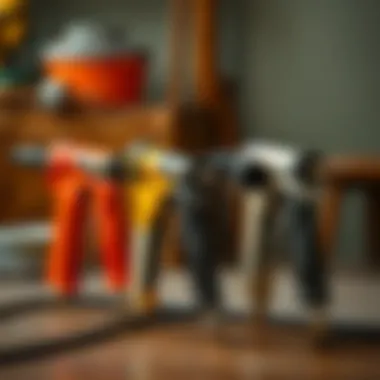
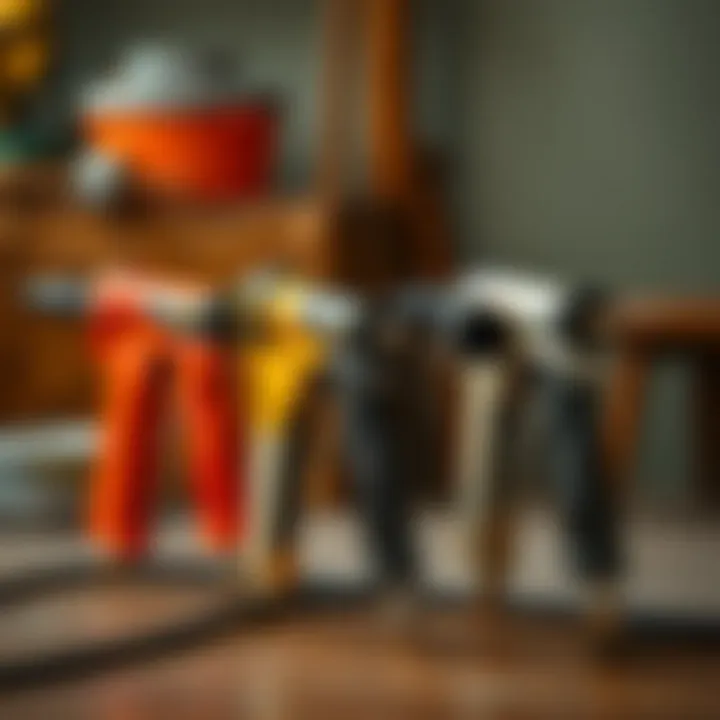
This groundwork lays the foundation for a successful painting experience. Proper room and surface preparation can't be overstated; it influences your end results dramatically. Next up, when you start painting, you’ll be glad you took these steps!
Paint Application Techniques
When it comes to using a paint gun, the techniques employed during application can have a profound impact on the final outcome. Mastering the right techniques not only ensures a professional-looking finish but also enhances efficiency and minimizes waste. This section breaks down proper holding techniques and discusses various spray patterns that are essential for achieving optimal results.
Proper Holding Techniques
Maintaining the correct grip on your paint gun is crucial. A firm yet relaxed grip allows for better control and reduces the likelihood of hand fatigue during longer painting sessions. Here are a few tips for holding a paint gun effectively:
- Feet Placement: Stand with your feet shoulder-width apart to provide a solid base. This posture enhances stability as you apply paint.
- Shooting Angle: Hold the spray gun at a 90-degree angle to the surface. This angle promotes an even coating and prevents paint from pooling.
- Distance: Keep the gun about 6 to 12 inches away from the surface depending on the type of paint and desired finish. Too close can lead to thick drips, while too far can cause a dry spray.
By mastering these elements, you set the stage for an efficient paint application that looks smooth and polished.
Spray Patterns and Techniques
Getting acquainted with different spray patterns equips you with the flexibility to tackle various surfaces and project types. Let’s delve into two popular techniques: the vertical spray technique and the horizontal spray technique. Each serves a unique purpose and has its own advantages.
Vertical Spray Technique
The vertical spray technique is commonly used for tall, narrow surfaces such as doors and tight corners. This method allows for a consistent and uniform application from top to bottom. The key characteristic of this technique lies in the upward sweep of the gun from the base to the top of the surface, creating a linear, vertical coat. It is particularly beneficial for door frames, windows, and walls because it minimizes dripping and uneven coverage.
One unique feature of the vertical spray is that it allows the painter to control the flow of paint effectively. By moving the gun in a steady motion, you can achieve a smooth finish that avoids build-up at any single point. However, it’s essential to maintain a consistent speed; too fast may lead to a light coat while too slow could cause runs.
Horizontal Spray Technique
Conversely, the horizontal spray technique is favored for larger, flat surfaces such as walls and ceilings. Its defining characteristic is the sweeping motion from left to right (or vice versa), which allows for wide coverage in a shorter timeframe. This technique is great for achieving a uniform finish across expansive areas.
What makes the horizontal spray technique distinctive is its efficiency in covering broad surfaces with fewer passes. Yet, it does require careful attention to overlap each pass sufficiently to avoid visible lines. Be conscious of the distance maintained from the surface; too much gap can lead to a dry spray, while being too close may result in runs.
Post-Painting Maintenance and Clean-Up
Maintaining your tools and ensuring proper clean-up after a painting project isn’t just an afterthought; it’s a crucial part of the entire process that can significantly affect the durability of your work and the longevity of your equipment. Investing time in post-painting maintenance not only prolongs the life of your paint gun but also ensures that your painting skills are not wasted next time you embark on a project.
Cleaning the Paint Gun
When you finish painting, it's essential to clean your paint gun thoroughly. Ignoring this task can lead to clogs or damage that can turn your valuable tool into just another piece of junk in the garage. Let's break this down into manageable steps:
- Disassemble the Gun: Start by taking apart the gun according to the manufacturer's instructions. Removing pieces like the nozzle, cup, and any filter is critical.
- Rinse and Wipe: If you've used water-based paint, a simple rinse with warm water, followed by wiping down the components with a soft cloth, often does the trick. For oil-based paints, you'll require a solvent such as mineral spirits or paint thinner. Be sure to do this in a well-ventilated area to avoid potential fumes.
- Flush the System: Run clean solvent through the gun to purge any leftover paint. This step is crucial, as it ensures no remnants are left to harden and cause blockages. Use a bucket or similar container to catch excess materials.
- Inspect for Damage: After cleaning, take a moment to inspect all parts for wear and tear. If parts look worn out, consider replacing them to maintain optimal performance next time.
- Reassemble: Once everything is clean and dry, carefully reassemble your paint gun, ensuring all pieces are correctly aligned.
Proper Disposal of Paint Materials
Disposal practices for paint materials are not just about keeping your space tidy; they also play a significant role in being environmentally responsible. Improper disposal can lead to harmful effects on the environment. Here are a few important considerations:
- Check Local Regulations: Before disposing of paint materials, it’s wise to check local regulations regarding hazardous waste. Many places have specific guidelines that must be followed.
- Store Leftover Paint: If you have leftover paint that is still usable, consider storing it appropriately. Make sure the container is sealed tightly and labeled with the date and type of paint for easy reference later.
- Disposal Methods: If the paint is no longer usable, contact local waste management for disposal options. Some areas hold hazardous waste drop-off days where you can give away items like this safely.
"Always think before tossing out – what seems like trash to you may harm the environment if not disposed of correctly."
- Recycling Options: Some facilities can recycle leftover paint. It’s worth investigating if your area offers options. This way, you can contribute to sustainability efforts while maintaining your home.
By following these steps, not only do you maintain your equipment and workspace, but you also embrace responsibility towards your environment. In the grand scheme, these actions culminate in a better home painting experience, equipping you for future endeavors.
Ending
In wrapping up this guide, it becomes evident that choosing and using a paint gun can significantly change the painting game for homeowners and DIY enthusiasts alike. The benefits of efficiency, versatility, and achieving a smooth finish cannot be overstated. However, the potential drawbacks, such as the learning curve and overspray, require careful consideration.
When deciding on a paint gun, assess your individual needs. Consider factors like the scale of your projects, the frequency of use, and your skill level. Each type of paint gun—from airless to HVLP—presents unique attributes suited for different tasks. After all, the right tool can make all the difference between a mediocre paint job and a superbly executed finish.
It's worth noting that preparation is key. The effort put into setting up the room and prepping surfaces will pay off in the final results. As highlighted earlier, mastering proper techniques not only ensures an aesthetically pleasing outcome but also helps in maintaining the tools effectively.
Also, post-painting cleanup and maintenance are critical in prolonging the life of your equipment. Taking the time to care for your paint gun, including thorough cleaning and proper disposal of paint materials, is a small price to pay for the benefit of having a reliable tool at your disposal for future projects.
"The goal of your painting project should be not just to complete it, but to complete it while maintaining high standards of quality and craftsmanship."
By considering these elements, you'll not only enhance your interior spaces but also embrace the entire painting process with a sense of confidence and skill. Ultimately, the comprehensive insights offered in this article aim to equip you with the knowledge needed to transform your home into a canvas, where each brushstroke tells a story.







